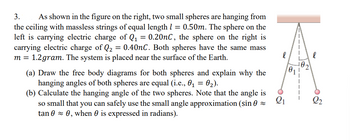Question

Transcribed Image Text:3. As shown in the figure on the right, two small spheres are hanging from
the ceiling with massless strings of equal length 1 = 0.50m. The sphere on the
left is carrying electric charge of Q₁ = 0.20nC, the sphere on the right is
carrying electric charge of Q₂ = 0.40nC. Both spheres have the same mass
m = 1.2gram. The system is placed near the surface of the Earth.
(a) Draw the free body diagrams for both spheres and explain why the
hanging angles of both spheres are equal (i.e., 0₁ = 0₂).
(b) Calculate the hanging angle of the two spheres. Note that the angle is
so small that you can safely use the small angle approximation (sin ≈
tan 0 ≈ 0, when 0 is expressed in radians).
Expert Solution
This question has been solved!
Explore an expertly crafted, step-by-step solution for a thorough understanding of key concepts.
Step by stepSolved in 4 steps with 16 images

Knowledge Booster
Similar questions
- Attached is question.arrow_forwardThe IKAROS spacecraft, launched in 2010, was designed to test the feasibility of solar sails for spacecraft propulsion. These large, ultralight sails are pushed on by the force of light from the sun, so the spacecraft doesn't need to carry any fuel. The force on IKAROS's sails was measured to be 1.12 mNmN. If this were the only force acting on the 290 kg spacecraft, by how much would its speed increase after 7.0 months of flight? Assume there are 30 days in each month.arrow_forwardYou and your secret celebrity crush pass each other in rockets that are each traveling 0.56c relative to the other. Your secret celebrity crush takes a nap and you decide to time how long the nap takes. In your frame, the nap takes 1.7 h. How long was the nap in your secret celebrity crush's frame? Unbeknownst to you, your secret celebrity crush's agent is onboard the celebrity's rocket and saw you timing the nap. Concerned, the agent decides to time how long you were timing the nap. In the agent's frame, how long were you timing your secret celebrity crush's nap?arrow_forward
- 106 MeV) is Extra: A very rare but occasionally observed decay of a muon µ (rest energy = into an electron e (rest energy 0.511 MeV) and a photon y (rest energy decays at rest by this mode, what is the kinetic energy of the electron and photon combined after the decay? (1M V = 10°eV = 1.6 x 10-13 J) zero). If a muonarrow_forwardExtra: You have two disks lying flat on ice, one has a string wrapped around the outside edge which unravels as you pull, the other has a string attached to a peg in the center. The discs have equal masses and dimensions and are initially at rest. If you start pulling both strings at the same time with the same constant force, at some time t later which of the two disks has moved further? Or have they both moved the same distance? Explain.arrow_forwardJames (mass 81.0 kg) and Ramon (mass 57.0 kg) are 20.0 m apart on a frozen pond. Midway between them is a mug of their favorite beverage. They pull on the ends of a light rope stretched between them. Ramon pulls on the rope to give himself a speed of 1.10 m/s. What is James's speed? It must have the proper dimensions of speed.arrow_forward
- The mass of an electron is 9.11 x 10 ^-31 kg. The mass of a proton is 1.67 x 10 ^-27 kg. They are about 5.3×10^ −11 m apart in a hydrogen atom. What is the gravitational force between these two particles in the hydrogenatom?arrow_forwardAt a particular instant, in a coordinate frame chosen by us, the Earth (mass = 6 x 1024 kg) is at location (-7.30 × 106, -7.80 × 106, 3.73 × 106) m and the Moon (mass = 7 x 10²² kg) is at location (-1.35 × 108, -2.50 × 10³, 2.82 × 108) m. A satellite with mass 5000 kg is at location (-1.18 × 10³, -2.73 × 10³, 3.10 × 108) m. What is the net force on the satellite? Assume that the gravitional force of the Sun is negligible. net = i i !)Narrow_forwardAn electron travels with v =5.90×10^6i^m/s through a point in space where E =(2.20×10^5i−2.20×10^5j^)V/m and B =−0.180k^T. What is the force on the electron? Express vector F in the form Fx, Fy, where the x and y components are separated by a comma.arrow_forward
- You are the pilot of a spacecraft intended for travel at very high speeds. Before leaving you measure the spacecraft to be 31.4 m long and have a mass of 5.28 x 104 kg. During your travel, you pass a planet and exchange information with an observer on the planet. You are told that your spacecraft has been measured to be 28.6 m long. a. How fast is your spacecraft travelling with respect to the planet? b. You are told there is a nearby planet that is stationary with respect to the first planet. The observer on the first planet says it will take you 25 s to reach the nearby planet. How far away does your co-pilot on the spacecraft say the nearby planet is? c. How much energy was required to accelerate your spacecraft to this speed?arrow_forwardScientists in the laboratory create a uniform electric field Ē = 1.0 x 10°k [V/m] in a region of space where B = 0. What are the fields in the reference frame of a rocket travelling in the positive x direction at 1.0 × 106 [m/s]?arrow_forwardAs the drawing shows, a carpenter on a space station has constructed a 30.0° ramp. A rocket moves past the space station with a relative speed of 0.863c in a direction parallel to side x. What does a person aboard the rocket measure for the angle of the ramp? Number i 30.0° X Unitsarrow_forward
arrow_back_ios
SEE MORE QUESTIONS
arrow_forward_ios